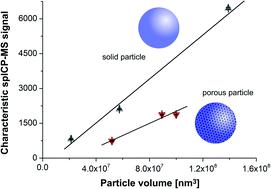当前位置:
X-MOL 学术
›
J. Anal. At. Spectrom.
›
论文详情
Our official English website, www.x-mol.net, welcomes your
feedback! (Note: you will need to create a separate account there.)
Porosity determination of nano- and sub-micron particles by single particle inductively coupled plasma mass spectrometry
Journal of Analytical Atomic Spectrometry ( IF 3.1 ) Pub Date : 2020-03-02 , DOI: 10.1039/d0ja00020e Albert Kéri 1, 2, 3, 4, 5 , András Sápi 2, 3, 4, 6 , Ditta Ungor 2, 3, 4, 5, 7 , Dániel Sebők 2, 3, 4, 6 , Edit Csapó 2, 3, 4, 5, 7 , Zoltán Kónya 2, 3, 4, 5, 7 , Gábor Galbács 1, 2, 3, 4, 5
Journal of Analytical Atomic Spectrometry ( IF 3.1 ) Pub Date : 2020-03-02 , DOI: 10.1039/d0ja00020e Albert Kéri 1, 2, 3, 4, 5 , András Sápi 2, 3, 4, 6 , Ditta Ungor 2, 3, 4, 5, 7 , Dániel Sebők 2, 3, 4, 6 , Edit Csapó 2, 3, 4, 5, 7 , Zoltán Kónya 2, 3, 4, 5, 7 , Gábor Galbács 1, 2, 3, 4, 5
Affiliation

|
A new porosity determination method for nano- and sub-micron particles is proposed, which is based on single particle inductively coupled plasma mass spectrometry (spICP-MS) measurements. The performance of the new method was tested on core–shell Ag–Au, hollow Au and mesoporous SiO2 nanoparticles of different sizes and porosities and it was found that its accuracy and precision (e.g. 1–2 rel.%) are comparable to those of reference methods, such as small angle X-ray scattering (SAXS), gas adsorption or transmission electron microscopy imaging (TEM). It can be applied to nano- and submicron particles in the complete mesoporous pore (2–50 nm) range. The application to macroporous particles is also possible, but it is limited in size to particles that can be fully decomposed by the plasma. The proposed new spICP-MS method provides an advantageous set of features that is unparalleled among the porosity determination methods, namely (i) it only requires a very small amount of particulate sample (micrograms or even less) in the form of a dilute dispersion (e.g. in a 105 mL−1 particle concentration), so there is not even a need for a dry sample; (ii) it works for open and closed pores equally well; (iii) the measurement and calculation are quick and simple, and only need the external diameter of the particle (from e.g. electron microscopy or dynamic light scattering (DLS) measurements) as input. The overall porosity determined can also be used to calculate the density of the particles, a feat which is not easy to achieve from such a small amount of sample.
中文翻译:

用单颗粒电感耦合等离子体质谱法测定纳米和亚微米颗粒的孔隙率
提出了一种基于单颗粒电感耦合等离子体质谱法(spICP-MS)的纳米级和亚微米级孔隙率测定方法。在不同尺寸和孔隙率的核-壳Ag-Au,中空Au和中孔SiO 2纳米颗粒上测试了该新方法的性能,发现其准确性和精密度(例如1-2 rel。%)与参考方法相当,例如小角度X射线散射(SAXS),气体吸附或透射电子显微镜成像(TEM)。它可以应用于整个中孔(2–50 nm)范围内的纳米和亚微米颗粒。也可以将其施加到大孔颗粒上,但是其尺寸限于可以被等离子体完全分解的颗粒。提出的新的spICP-MS方法提供了一组有利的功能,这些功能在孔隙率测定方法中是无与伦比的,即(i)它仅需要非常少量的稀分散体形式的颗粒样品(微克甚至更少)(例如在10 5 mL -1中颗粒浓度),因此甚至不需要干燥的样品;(ii)它对打开和关闭的毛孔同样有效;(iii)测量和计算快速简便,并且仅需要粒子的外径(例如,通过电子显微镜或动态光散射(DLS)测量)作为输入。所确定的总孔隙率也可用于计算颗粒的密度,这是很难从如此少量的样品中实现的。
更新日期:2020-03-02
中文翻译:

用单颗粒电感耦合等离子体质谱法测定纳米和亚微米颗粒的孔隙率
提出了一种基于单颗粒电感耦合等离子体质谱法(spICP-MS)的纳米级和亚微米级孔隙率测定方法。在不同尺寸和孔隙率的核-壳Ag-Au,中空Au和中孔SiO 2纳米颗粒上测试了该新方法的性能,发现其准确性和精密度(例如1-2 rel。%)与参考方法相当,例如小角度X射线散射(SAXS),气体吸附或透射电子显微镜成像(TEM)。它可以应用于整个中孔(2–50 nm)范围内的纳米和亚微米颗粒。也可以将其施加到大孔颗粒上,但是其尺寸限于可以被等离子体完全分解的颗粒。提出的新的spICP-MS方法提供了一组有利的功能,这些功能在孔隙率测定方法中是无与伦比的,即(i)它仅需要非常少量的稀分散体形式的颗粒样品(微克甚至更少)(例如在10 5 mL -1中颗粒浓度),因此甚至不需要干燥的样品;(ii)它对打开和关闭的毛孔同样有效;(iii)测量和计算快速简便,并且仅需要粒子的外径(例如,通过电子显微镜或动态光散射(DLS)测量)作为输入。所确定的总孔隙率也可用于计算颗粒的密度,这是很难从如此少量的样品中实现的。











































 京公网安备 11010802027423号
京公网安备 11010802027423号